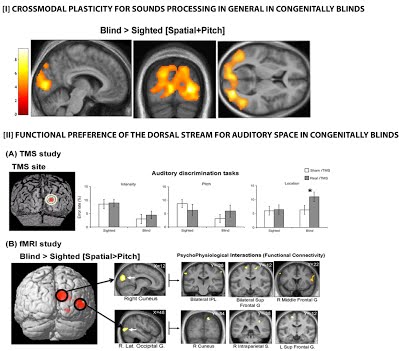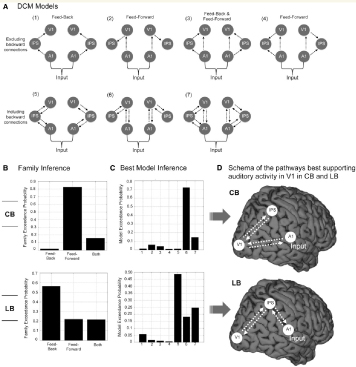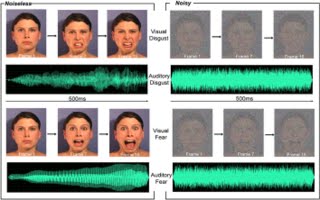The general goal of our research is to clarify the mechanisms of the interplays between our senses observed at behavioral and brain levels in human.
[I] Crossmodal plasticity in sensory deprived cortices
We investigate the impact of sensory deprivation in shaping the functional properties of the immature and mature sensory cortices. The question here notably relates to how the brain is able to rewire its components in order to compensate sensory deprivation (e.g. blindness and deafness). Sensory experience not only provides us with information about the environment, but it also sculpts the function and structure of the brain in order to create the most appropriate network to handle this environment. However, such experience-dependent plasticity arises in a brain constrained by phylogenetic and ontogenetic past experience. It is this interaction between sensory experience and the structure and function of the brain that is one of the main research activities in the laboratory. Specifically, we investigate if the cross-modal recruitment of the sensory deprived regions may follow organizational principles similar to the functional topography of the region observed in non-deprived individuals.
Selected review publications:
- Dormal G, Lepore F, Collignon O (2012) Plasticity of the dorsal “spatial” stream in visually deprived individuals. Neural Plasticity.
- Collignon O., Dormal G. & Lepore, F. (In Press). Building the brain in the dark: Functional and specific crossmodal reorganization in the occipital cortex of blind individuals. Chapter in "Plasticity in Sensory Systems" edited by M. Jenkin, J. Steeves, and L. Harris. Cambridge University Press.
- Collignon O., Champoux F., Voss P., Lepore F. (2011) Sensory Rehabilitation in the Plastic Brain. Progress in Brain Research, 191:211-31.
- Dormal G. & Collignon O. (2011) Functional selectivity in sensory deprived cortices. Journal of Neurophysiology, 105(6): 2627-30.
- Collignon, O., Voss, P., Lassonde, M., & Lepore, F. (2009) Crossmodal plasticity for the spatial processing of sounds in visually deprived subjects. Experimental Brain Research, 192(3): 343-58.
Functional organization of sensory deprived cortices


Selected publications:
- Collignon, O., Dormal, G., Albouy G., Vandewalle G., Voss P., Phillips C., Lepore, F. (In Press) Impact of blindness onset on the functional organization and the connectivityof the occipital cortex. Brain.
- Collignon O., Vandewalle G., Voss P., Albouy G., Charbonneau G., Lassonde M., Lepore F. (2011) Functional specialization for auditory-spatial processing in the occipital cortex of congenitally blind humans. PNAS, 108, 4435-4440.
- Collignon, O., Davare, M., Olivier, E. & De Volder, A.G. (2009) Reorganisation of the right occipito-parietal stream for auditory spatial processing in early blind humans. A Transcranial Magnetic Stimulation study. Brain Topography, 21, 232-40 [Special Issue on Multisensory Integration].
- Collignon, O., Lassonde, M., Lepore, F., Bastien, D., & Veraart, C. (2007). Functional cerebral reorganization for auditory-spatial processing and auditory substitution of vision in early blind subjects. Cerebral Cortex, 17(2):457-465.
- Poirier, C., Collignon, O., Scheiber, C., Tranduy, D., Renier, L., Vanlierde, A., Veraart, C. & De Volder, A. (2006). Activation of visual motion areas by auditory motion processing in blind humans. Neuroimage, 31(1), 279-85.
Functional changes in the occipital cortex of sight-recovery patients
Selected publications:
- G Dormal, F Lepore, M Harissi-Dagher, A Bertone, B Rossion, & O Collignon. Recovering sight in adulthood leads to rapid neurofonctional reorganization of visual functions. Journal of Vision 12 (9), 1279-1279.
Sensory compensations in blind individuals
Selected publications:
- Collignon O., Charbonneau G., Lassonde M., Lepore F. (2009) Early visual privation alters multisensory processing in peripersonal space. Neuropsychologia, 47, 3236-3243.
- Collignon, O., & De Volder, A. (2009) Further evidence that congenitally blind participants react faster to auditory and tactile spatial targets. Canadian Journal of Experimental Psychology, 63(4): 287-93.
- Collignon, O., Renier, L., Bruyer, R., Tranduy, D. & Veraart, C. (2006). Improved selective and divided spatial attention in early blind subjects. Brain Research, 1075(1), 175-82.
[II] Multisensory Integration (MSI)
Our perceptual world is made up of events that usually stimulate more than one sense at a given time.
The brain must therefore integrate sources of information originating from multiple sensory modalities in order to create a unified and coherent internal representation of our external environment. We study how this multisensory integration (MSI) ability ultimately allows us to interact with our surroundings and others in an optimal fashion.
Spatial constraints on MSI
Selected publications:
- Girard, S., Collignon, O., Lepore, F. (2011) Multisensory gain within and across hemispaces in simple and choice reaction time paradigms. Experimental Brain Research, 214: 1-8.
- Girard S, Pelland M, Lepore F, & Collignon O (In Press) Impact of the spatial congruence of redundant targets on within-modal and cross-modal integration. Experimental Brain research.
- Charbonneau G, Veronneau M, Boudrias-Fournier C, Lepore F, & Collignon O. (2013) The ventriloquist in periphery: Impact of eccentricity-related reliability on audio-visual localization. Journal of Vision, 13(12):20, 1–14.
MSI of emotional expressions
Selected publications:
• Collignon, O., Girard, S., Gosselin, F., Saint-Amour, D., Lepore, F., & Lassonde, M. (2010) Women process multisensory emotion expressions more efficiently than men. Neuropsychologia, 48(1): 220-5.
• Collignon, O., Girard, S., Gosselin, F., Roy, S., Saint-Amour, D., Lassonde, M., & Lepore, F. (2008). Audio-Visual Integration of Emotion Expression. Brain Research, 1242: 126-135. [Special Issue on Multisensory Integration].
• Charbonneau G., Bertone A., Lepore F., Nassim M., Lassonde M., Mottron L., & Collignon O. (In Press) Multilevel alterations in the processing of audio-visual emotion expressions in Autism Spectrum Disorders. Neuropsychologia
The development of MSI
The multisensory cortex
Selected publications:
- Collignon, O., Davare, M., De Volder, A.G., Poirier, C., Olivier, E. & Veraart, C. (2008). Time-course of posterior parietal and occipital cortices contribution to sound lateralization. Journal of Cognitive Neuroscience, 20: 1454-1463.
- Poirier, C., Collignon, O., Schreiber, C., Renier, L., Vanlierde, A., Tranduy, D., Veraart, C., De Volder, A. (2005). Specific activation of the V5 brain area by auditory motion processing: an fMRI study. Cognitive Brain research, 25(3), 650-8.
MSI in neurological conditions
We study MSI in special populations mainly for two reasons: (1) such work often yields insights into normal functioning of MSI; (2) it helps to better understand the cognitive peculiarities of these populations and may lead to the development of neuromarkers of the condition, and (3) this research may eventually translate into tangible improvements in the multisensory functioning of the affected populations.
MSI in autism
Selected publications:
- Collignon O, Charbonneau G, Nassim M, Peters F, Lassonde M, Lepore F, Mottron L, & Bertone A (In Press) Reduced multisensory facilitation in persons with autism. Cortex.
- Charbonneau G., Bertone A., Lepore F., Nassim M., Lassonde M., Mottron L., & Collignon O. (In Press) Multilevel alterations in the processing of audio-visual emotion expressions in Autism Spectrum Disorders. Neuropsychologia
MSI in blind individuals
Selected publications:
- Collignon O., Charbonneau G., Lassonde M., Lepore F. (2009) Early visual privation alters multisensory processing in peripersonal space. Neuropsychologia, 47, 3236-3243.
- Champoux F., Collignon O., Bacon B., Lepore F., Zatorre R.J., Théoret H. (2011) Early- and late-onset blindness both curb audiotactile integration on the parchment-skin illusory task. Psychological Science, 22(1): 19-25.
[III] Space, number, and time in the blind
The goal here is to study how developmental vision drives the development of the automatic recoding of specific sensory-perceptual-motor processing in an external/allocentric space.
Selected publications:
 • Crollen V, Noël MP, Seron X, Mahau P, Lepore F and Collignon O. (2014). Visual experience influences the interactions between fingers and numbers. Cognition, 133: 91–96.
• Crollen V, Noël MP, Seron X, Mahau P, Lepore F and Collignon O. (2014). Visual experience influences the interactions between fingers and numbers. Cognition, 133: 91–96.
• Crollen V, & Collignon O (2012) Embodied space in early blind individuals. Frontiers in Psychology.
• Crollen V, Dormal G, Seron, X, Lepore F, & Collignon O. (In Press) Embodied numbers: Early vision drives the reference frame used for the spatial representation of numbers. Cortex.
• Crollen V., Mahe R., Collignon O., & Seron X. (2011) The role of vision in the development of finger-number interactions: Finger-counting and finger-montring in blind children. Journal of Experimental Child Psychology, 109(4): 525-39.
• Collignon O., Charbonneau G., Lassonde M., Lepore F. (2009) Early visual privation alters multisensory processing in peripersonal space. Neuropsychologia, 47, 3236-3243.

